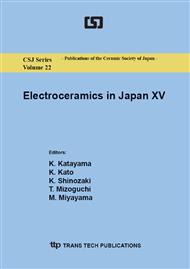p.7
p.12
p.16
p.20
p.25
p.29
p.34
p.41
p.45
Crystal Growth and Characterization of (Bi0.5Na0.5)TiO3-BaTiO3 Single Crystals Obtained by the Top-Seeded Solution Growth Method under High-Pressure Oxygen Atmosphere
Abstract:
A single crystal of ferroelectric 0.88(Bi,Na)TiO30.12BaTiO3 (BNTBT) solid solution with tetragonal P4mm structure was grown by the top-seeded solution growth (TSSG) method at a high oxygen pressure (PO2) of 0.9 MPa. The crystals grown by the high-PO2 TSSG method exhibited a large remanent polarization (Pr) of 54 μC/cm2, which leads to a spontaneous polarization of 54 μC/cm2. The large Pr compared with that of crystals grown at PO2 = 0.1 MPa is suggested to originate from a low oxygen vacancy concentration for the crystals grown at a higher PO2. The high-PO2 TSSG method was demonstrated to be effective for obtaining BNTBT crystals with superior polarization and piezoelectric properties.
Info:
Periodical:
Pages:
25-28
Citation:
Online since:
July 2013
Authors:
Price:
Сopyright:
© 2013 Trans Tech Publications Ltd. All Rights Reserved
Share:
Citation:


